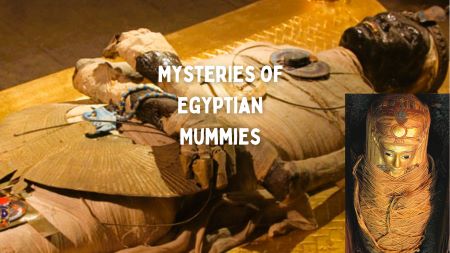Unraveling the Mysteries of Egyptian Mummies: A Journey through Time

Egyptian Mummies
Egyptian mummies, with their air of mystery and intrigue, have captivated the imagination of people for centuries. These ancient relics, carefully preserved through a meticulous process, hold within them not just the remains of individuals, but also a window into the beliefs, practices, and daily life of a civilization that thrived along the banks of the Nile.
The Origins of Mummification
The practice of mummification in ancient Egypt can be traced back over 5,000 years. Initially, it was a privilege reserved for pharaohs and high-ranking officials, but over time, it became more widespread, encompassing a broader segment of society. The process of mummification was deeply entwined with their religious beliefs, as Egyptians held a strong conviction in an afterlife.
The Mummification Process
Mummification was a meticulous and complex process, carried out by skilled embalmers. It involved several stages, each executed with great care. The organs were carefully removed, preserving only the heart as it was considered the seat of wisdom and emotions. The body was then treated with various preservatives, followed by the wrapping of the deceased in layers of linen. This process ensured the body’s preservation for eternity.
Significance in Ancient Egyptian Culture
In ancient Egypt, mummies played a pivotal role in their belief system. They were considered vessels that housed the soul for the afterlife. Mummies were entombed with an array of offerings, from food to precious objects, to ensure the individual’s comfort and sustenance in the next life. The elaborate burial rituals reflected the profound respect and reverence Egyptians held for the deceased.
Insights Gained from Mummies
Today, thanks to advancements in technology and archaeological techniques, we’ve been able to glean a wealth of information from Egyptian mummies. Through careful examination, we’ve learned about their medical practices, diet, and even the diseases that afflicted them. The inscriptions and artifacts found in tombs have provided invaluable insights into their religious beliefs and societal structure.
The Legacy of Egyptian Mummies
The legacy of Egyptian mummies stretches far beyond the banks of the Nile. They have been instrumental in reshaping our understanding of ancient civilizations. Mummies have not only provided us with a tangible connection to the past but have also ignited a passion for archaeology and Egyptology in countless individuals around the world.
In conclusion, Egyptian mummies stand as a testament to the ingenuity and reverence of an ancient civilization. They are more than mere artifacts; they are windows into a world that existed millennia ago. As we continue to unravel their secrets, we deepen our appreciation for the rich tapestry of human history.
Remember, the next time you gaze upon the face of an Egyptian mummy, you’re not just looking at a relic. You’re gazing into the eyes of a person who lived, loved, and believed in the promise of eternity.








